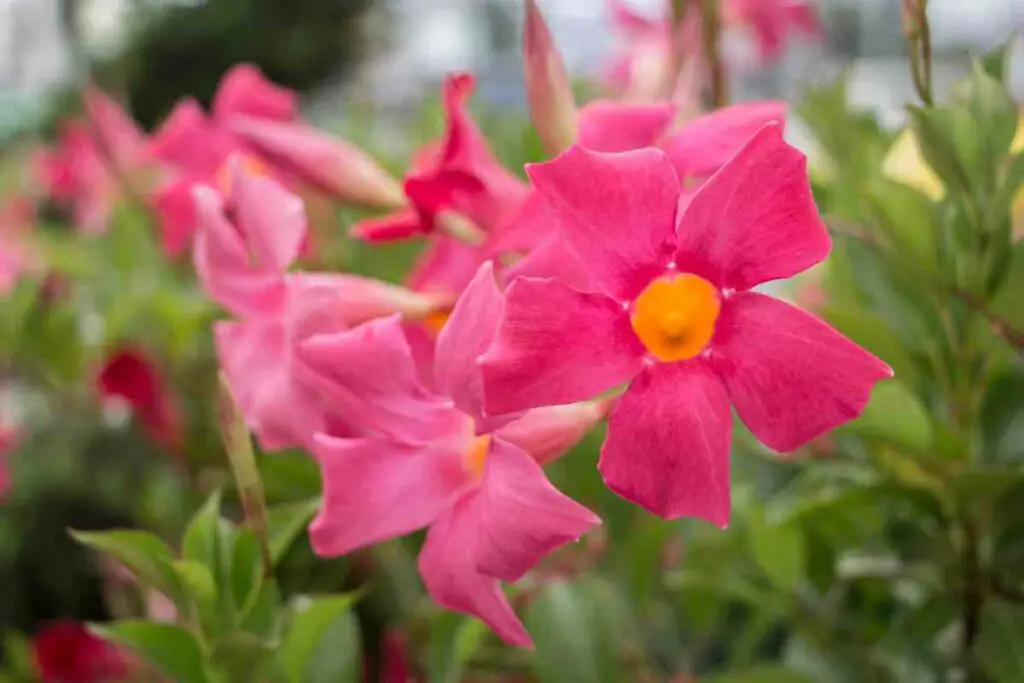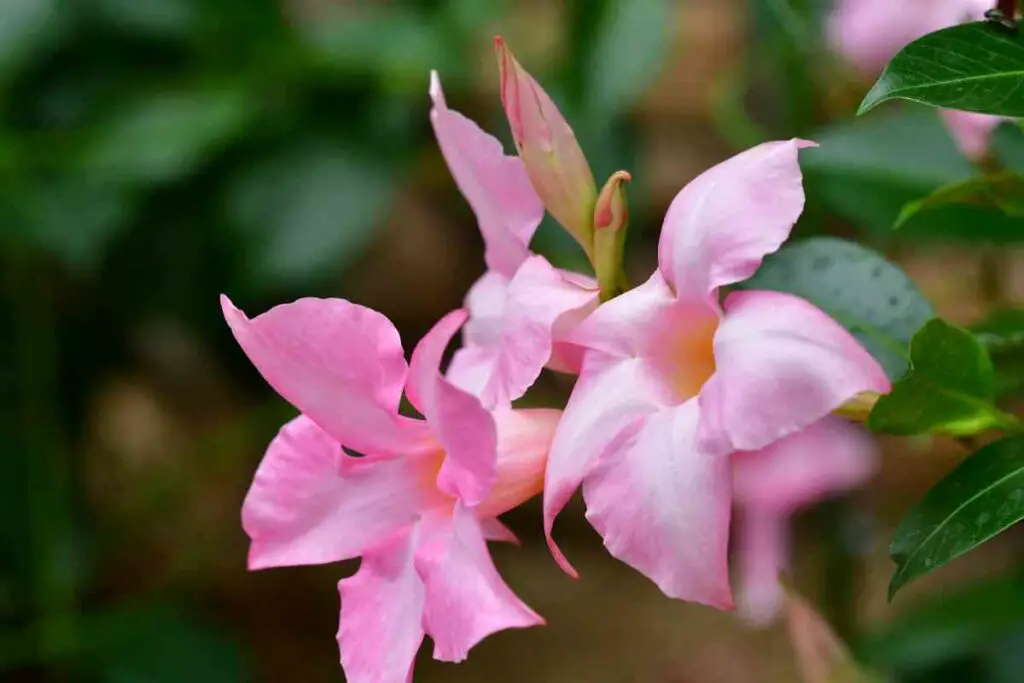You should fertilize Mandevilla in the spring. A general fertilizer can offer them the nutrients they need to flower and grow. After feeding the plants, you should water them to help the fertilizer seep into the soil.
Mandevilla is beautiful flowers, but you must offer them enough nutrients to bloom. It can take a while to work out the perfect feeding schedule for them, but all the details are below.

Table of Contents
When Do I Fertilize Mandevilla?
Generally, you should fertilize Mandevilla plants at least two times per year. First, you need to feed them in the spring, then again in the late summer.
It is crucial to provide your flowers with fertilizer in the spring, allowing them to thrive and bloom. Many Mandevilla plants won’t flower well without a consistent fertilizing schedule.
You’ll want to wait for new vine growth. Once you spot the Mandevilla spreading during the spring, that’s the best time to fertilize them.
Then fertilize them again during the summer. This flower blooms during the summer and fall, so providing it with extra nutrients can help the petals last much longer.
In short, feed your Mandevilla plants at least twice a year. Using the fertilizer we’ve provided at the bottom, fertilize 1-2 times a week for the best results.
Prices pulled from the Amazon Product Advertising API on:
Product prices and availability are accurate as of the date/time indicated and are subject to change. Any price and availability information displayed on [relevant Amazon Site(s), as applicable] at the time of purchase will apply to the purchase of this product.
What Fertilizer is Best for Mandevilla Plants?
Mandevilla plants do the best with a slow-release formula. You apply the fertilizer once, and it lasts the entire season. It’s great for flowering plants because they always have access to the nutrients they need to bloom.
You can also use other fertilizers than a slow-release, although you will need to apply them more frequently than once yearly.
Gardeners recommend applying it throughout the entire growing season. While that’s fine for some who want to garden actively, slow-release is the better choice for most people. If you don’t have time to apply the fertilizer so frequently, your plants won’t suffer.
Next, you must choose a nutrient NPK (nitrogen, phosphorus, potassium) ratio of 10-10-10. This ratio means that the three main nutrients are in equal parts, so many gardeners also use a 20-20-20 formula for their Mandevillas.
You’ll need to make sure that you wear gardening gloves and a breathing mask when working with the fertilizer. Finally, you must follow all the instructions on the fertilizer’s packaging. Some brands have different guidelines than others, so you need to know you’re using them correctly.
How Do I Apply Fertilizer to Mandevillas?
It’s easy to apply a slow-releasing fertilizer to your Mandevilla plants. Once you have your fertilizer, all you need to do is mix it in the soil. You want to try to combine it as evenly as possible. Most people prefer gardening gloves to stir the food into the soil with their hands. For Mandevillas, you need the fertilizer to go a few inches deep.
It’s a bit different if you’re using a water-soluble fertilizer since you’ll need to apply it much more frequently. You must check the instructions that come with the fertilizer, but generally, you can do the following:
- Dissolve some of the fertilizer in a gallon of distilled water.
- Water the Mandevillas at least once per week using this fertilizer solution.
- Continue watering the Mandevillas as usual for the rest of the week.
The instructions on the fertilizer should tell you how much fertilizer to water you need. Some require more or less than others, so it’s best to research the product you’re using to get the best results with your Mandevillas.

Can I Over-Fertilize Mandevilla?
It is possible to overfeed your Mandevilla vines. While they need fertilizer to grow, overfeeding the plant can cause them harm and stop them from blooming. Some signs of overfeeding your Mandevilla include:
- Sudden leaf fall
- Stunted growth
- Leaves that appear brown, crunchy, and burned
- Discoloration
- White dust in the soil
You’ll need to stop using fertilizer and do your best to correct the soil to make the plants healthy again. Watering the soil will help drain away some of the fertilizer.
Then, you’ll want to remove the top layer of the earth and dispose of it. Remove any dead plants and leaves, and do your best to keep the growing area clean.
Overall, the best way to help your Mandevillas is to stop feeding them and give them a lot of water to wash away the fertilizer. The soil should recover quickly, and the flowers will follow after a few weeks.
Will Mandevillas Recover From Overfeeding?
Overfeeding any plant can lead to damage, known as fertilizer burn. These fertilizers can contain large amounts of salt, which dry out plants and cause harm in excess. It can be fatal to your Mandevillas if you don’t deal with the issue early enough.
However, they can recover if you start treating them immediately. The sooner you start reversing the overfeeding of your flowers, the more likely they will survive the fertilizer burn.
You can’t bring the dead leaves back to life, so you must remove them. If left for too long, they’ll fall into the soil and turn into mulch, which your plants don’t want when already overfed.
Watch your Mandevillas as they recover. It helps to take photos to compare previous days and see if the plant is getting any better.
Sometimes you need to transfer Mandevillas to another location while you flush the fertilizer chemicals from your garden. So, they can recover, but you must intervene fast to stop fertilizer burn from killing your flowers.
Is It Easy To Take Care of Mandevillas?
It’s pretty easy to take care of Mandevilla flowers. However, you will need to get their growing conditions correct first. The vines like light and warmth, so you don’t want to put them anywhere that’s too shady.
Most people prefer growing them in pots so they can move them as needed. If there’s a frost coming, you can bring them inside quickly.
The most challenging part of caring for Mandevillas for most people is getting their fertilizing schedule and soil conditions correct.
As long as you give them fertilizer a few times a year and the soil they like, these flowers are very low-maintenance.
Finally, you also need to keep the soil moist. Since these flowers love the warmth, Mandevillas’ soil can dry out quickly. It’s best to keep an eye on their soil and develop a frequent watering routine.
What Soil is Best for Mandevillas?
Using suitable soil for your Mandevillas will allow them to produce the most stunning blooms. You’ll want to inspect your soil before planting them. It should have a pH level of about 6.6 to 7.8 and plenty of nutrients.
Mandevilla tends to like soil that’s loose and drains well. The best way to make soil for these flowers would be to use peat moss and homemade compost.
Many gardeners also say to add some sand to the ground since it helps keep it loose for the plants.
However, even if you make your own soil for your Mandevillas, you’ll still need to fertilize them at least two times each year. The compost adds nutrients to the soil and enhances the conditions for the plants.
At the same time, the fertilizer feeds the plants directly. Without a good fertilizer, your Mandevilla may not bloom well.
Overall, your Mandevillas will do the best in sandy soil. It’s loose and drains water well, which can stop root rot. Fertilizers and compost can improve the soil for the plants, so it’s also best to use them regularly.
How Long Do Mandevilla Blooms Last?
You’ll get stunning Mandevilla blooms if you follow a good feeding and watering schedule with your flowers. When they have ample access to nutrients, these flowers send out more vines, which allows them to have more blooms.
The Mandevilla’s growth will speed up drastically during the summer, so ensure they get enough water. If you take care of them well, the Mandevillas will reward you with long-lasting blooms.
Mandevilla bloom with beautiful, fragrant blossoms during the spring and fall. They’ll last until the first frost in the fall. If you live somewhere that doesn’t have hard freezes; the flowers will continue appearing year after year in the spring. Otherwise, you’ll need to replant them after winter ends.
In short, you can expect your Mandevilla blooms to last from the spring until the first frost of autumn. You’ll receive a ton of flowers if you carefully feed the plant.
Should I Deadhead My Mandevilla Plant?
You don’t need to deadhead your Mandevilla as long as you give it ample food and water. It will keep producing blooms under the right conditions, even if it has wilted flowers hanging onto it.
However, many gardeners prefer to deadhead their Mandevilla to keep it looking nice. It will appear fuller and much healthier if you remove the dead flowers from the vines. You’ll also want to cut back any dried-up vines.
So, you don’t need to deadhead Mandevillas unless you want to. While doing so is a bit more work, many gardeners appreciate the results.
Conclusion
In conclusion, fertilizing Mandevilla is an important aspect of its care to ensure healthy growth and abundant blooms.
Mandevilla is a tropical vining plant that prefers regular and consistent fertilization, but it is important to use the right type of fertilizer and to apply it at the right time.
A balanced, water-soluble fertilizer with a ratio of 10-10-10 or 20-20-20 should be applied every 2-4 weeks during the growing season. It is also important to avoid over-fertilizing, as this can lead to leaf burn and poor flower production.
It is also important to make sure the soil is well-draining and the plant is not overwatering.
Additionally, Mandevilla responds well to a monthly application of a balanced fertilizer specifically formulated for blooming plants to help encourage more blooms.
- How to Build a Planter Box for Bamboo: A Step-by-Step Guide

- Can Robotic Lawnmowers Handle Steep Slopes?

- Do You Need a Specific Lawn for a Robotic Lawnmower? Expert Advice

- Are Robotic Lawnmowers Safe for Pets and Children? Safety Features of Robotic Lawnmowers

- Why Use Robotic Lawnmowers? Advantages of Using a Robotic Lawnmower

- Is the GARDENA SILENO City 300 Cordless or Corded? A Clear Answer















